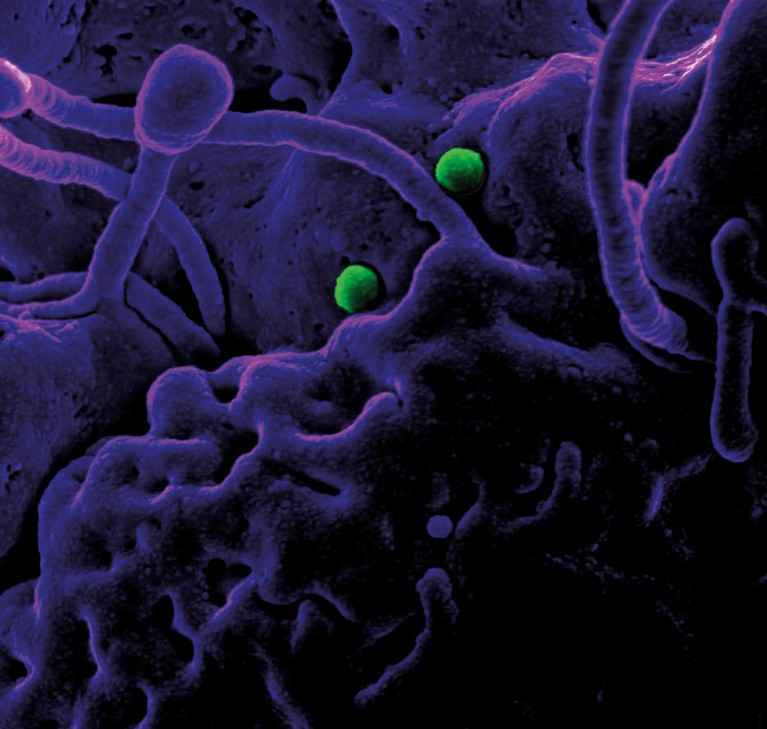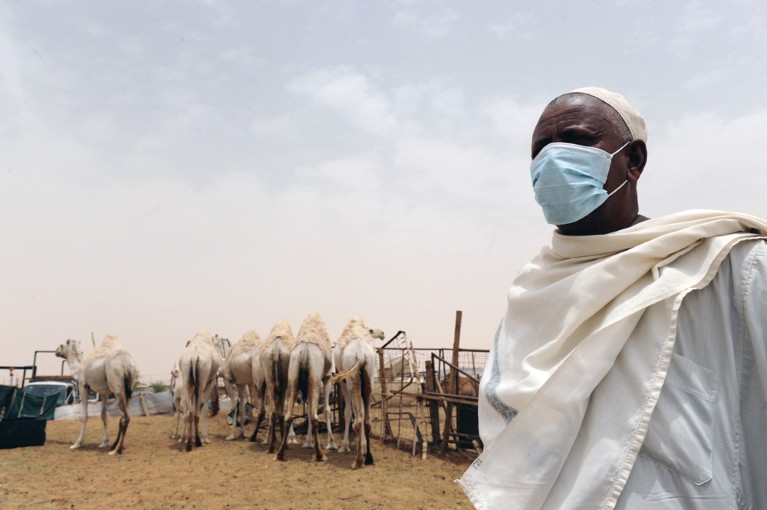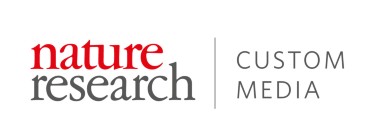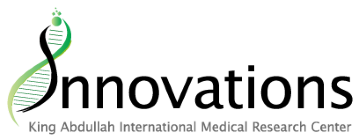
MERS-CoV particles on camel epithelial cells.© NIAID IN COLLABORATION WITH COLORADO STATE UNIVERSITY/ CC BY 2.0
MERS emerged in Saudi Arabia in September 2012, but laboratory-confirmed cases of infection have since been reported in 27 countries.
Though more than 1,800 MERS cases have been reported worldwide, Saudi Arabia has been the site of the lion’s share. Every year, several million people take the Hajj pilgrimage to Mecca, increasing fears of a rapid global spread of MERS and other infectious diseases.
As the epicentre of the syndrome, Saudi Arabia has become intrinsic to international efforts to combat its spread. Researchcarried out in the kingdom has contributed to understanding the virus’s biology and to the development of vaccines.
“Saudi researchers have made significant contributions to identifying the clinical presentation of the disease, so that physicians are better able to identify infections,” says KAIMRC’s Hanan Balkhy, also executive director of the Infection Prevention and Control Department at the Ministry of National Guard–Health Affairs.
“They have also made important progress in identifying risk factors for the disease, and in evaluating the effectivenessof treatments.”
Identifying the source
MERS is a respiratory illness caused by the MERS-Coronavirus (MERS-CoV), which was initially thought to spread from bats to humans via consumption of food contaminated with bat droppings.
In 2014, however, researchers from King Faisal University, working with collaborators in Egypt and Hong Kong, reported that they had isolated the MERS Coronavirus from a herd of dromedary camels1 on a farm in the oasis region of Al-Hasa, in eastern Saudi Arabia.
This confirmed that camels harbour MERS-CoV as intermediate hosts for the virus, which replicates in large quantities in their cells. Camels are likely responsiblefor spreading the infection to people who come into close contact with them.
Later that year, researchers at the King Fahd Center for Medical Research provided evidence of direct transmission ofMERS-CoV from camels to humans2.
More recently, Saudi researchers published the first MERS case control study —a method used to compare patients witha particular disease to those without it and establish how frequently they have been exposed to risk factors. This helpsdetermine the relationship between risk factors and the disease.
Researchers from the King Faisal Specialist Hospital and Research Centre in Jeddah, together with collaboratorsfrom the U.S. Centers for Disease Control and Prevention, identified all 535 known cases of MERS infection reportedin Saudi Arabia between March and November 2014, and compared them to 116 uninfected individuals by assessingtheir underlying medical conditions and direct environmental exposure to known risk factors.
This showed once again that those people who came into direct or indirect contact with dromedary camels were far more likely to be infected with MERS. The study findings3 reiterated that activities such as milking, feeding and slaughtering camels increased risk of infection, whereas drinking unpasteurised camel milk did not.
Shortly after these findings were published, the Saudi Arabian Ministry of Agriculture issued a statement advising people who come into regular contact with camels to “exercise caution and follow preventative measures” to minimise the spread of infection by wearing face masks and gloves, and washing their hands before and after any contact. Health officials have also warned people to avoid contact with camels altogether, unless necessary.
Developing prevention strategies
Since then, the Saudi government has been working closely with the World Health Organization to put effective measures in place for the Hajj pilgrimage. Efforts include raising awareness about MERS infection and heightened surveillance to prevent outbreaks. Visitors to Mecca are also advised to cover their mouths and noses when coughing or sneezing and to wash their hands regularly to minimise spread.
Healthcare workers are at a particularly high risk of infection, and there have been a number of MERS outbreaks in Saudi hospitals in the past three years. Immediately after each of these events, the Saudi Arabian Ministry of Health dispatched rapid response teams to the hospitals to identify others who may have been infected and enforce measures of infection control.
Balkhy says that the research has led to major changes in healthcare policies surrounding infection risk. “Identifying the method of transmission of the virus and the risk to healthcare providers has created a major transformation in the quality and standards in hospitals,” she says.
“The research also led to the creation of a specific unit in the Ministry of Health that audits infection control practices, in order to ensure that hospitals are properly prepared.”

Researchers have identified dromedary camels as a possible reservoir for the coronavirus causing MERS.© FAYEZ NURELDINE/AFP/GETTY IMAGES
Even so, much remains unknown. The exact mechanism of animal-to-human transmission is still unclear, for example, and researchers in Saudi Arabia and elsewhere are scrambling to develop an effective vaccine.
Last year, the King Abdulaziz City for Science and Technology (KACST) launched a comprehensive MERS-CoV research program in co-operation with the Ministries of Health and Agriculture.
Working with the International Vaccine Institute, the Saudi Ministry of Health also co-organized a workshop in Riyadh for researchers, funding agencies and non-governmental organizations, to discuss how to accelerate the fight against MERS.
According to the workshop report, all interested parties recognize the need to cooperate, and have resolved to formalize collaborations to maximize investment in MERS research, produce reliable data, and influence public health policy.
Balkhy says that she and her colleagues at KAIMRC are already collaborating on many other projects, most notably with researchers at the University of Oxford, to realise these goals.


